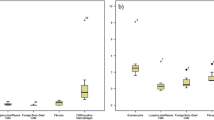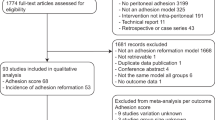Abstract
Separation of traumatized tissue represents the only promising strategy in postoperative adhesion prevention, a relevant clinical problem after surgical intervention. In the present study scanning electron microscopy (SEM) and subsequent morphometry were used to analyse the tissue response to five commercial adhesion barriers. Standardised peritoneal lesions in Wistar rats were covered with solid and viscous barrier materials and semiquantitatively analysed 14 days postoperatively. Striking morphological differences in lesion surface organisation between the barrier groups became apparent with colonisation of the barrier by mesothelial cells to different degrees. Furthermore, the mesothelial cells showed either a normal or activated phenotype depending on the underlying biomaterial. These experiments demonstrate that the examination by SEM gives useful insights into the performance of barrier materials and the cellular processes of adhesion prevention, since mesothelial cells play an active role in the pathogenesis of adhesion formation.


Similar content being viewed by others
References
di Zerega GS, Cortese S, Rodgers KE, Block KM, Falcone SJ, Juarez TG, et al. A modern biomaterial for adhesion prevention. J Biomed Mater Res B Appl Biomater. 2007;81(1):239–50.
Maciver AH, McCall MD, Edgar RL, Thiesen AL, Bigam DL, Churchill TA, et al. Sirolimus drug-eluting, hydrogel-impregnated polypropylene mesh reduces intra-abdominal adhesion formation in a mouse model. Surgery. 2011;150(5):907–15.
Ellis H, Moran BJ, Thompson JN, Parker MC, Wilson MS, Menzies D, et al. Adhesion-related hospital readmissions after abdominal and pelvic surgery: a retrospective cohort study. Lancet. 1999;353(9163):1476–80.
Rajab TK, Wallwiener M, Talukdar S, Kraemer B. Adhesion-related complications are common, but rarely discussed in preoperative consent: a multicenter study. World J Surg. 2009;33(4):748–50.
Almeida OD Jr, Val-Gallas JM. Conscious pain mapping. J Am Assoc Gynecol Laparosc. 1997;4(5):587–90.
Howard FM, El-Minawi AM, Sanchez RA. Conscious pain mapping by laparoscopy in women with chronic pelvic pain. Obstet Gynecol. 2000;96(6):934–9.
Boland GM, Weigel RJ. Formation and prevention of postoperative abdominal adhesions. J Surg Res. 2006;132(1):3–12.
Brochhausen C, Schmitt VH, Krämer B, Rajab TK, Wallwiener M, Planck C, et al. Intraperitoneale adhäsionen–Eine Herausforderung an der Schnittstelle von Materialforschung und Biomedizin. Bio Materialien. 2009;10:7–17.
Wallwiener M, Brucker S, Hierlemann H, Brochhausen C, Solomayer E, Wallwiener C. Innovative barriers for peritoneal adhesion prevention: liquid or solid? A rat uterine horn model. Fertil Steril. 2006;86(4 Suppl):1266–76.
Marana R, Muzii L. Infertility and adhesions. In: di Zerega GS, editor. Peritoneal surgery. New York: Springer; 2000. p. 329–33.
Lower AM, Hawthorn RJ, Ellis H, O’Brien F, Buchan S, Crowe AM. The impact of adhesions on hospital readmissions over 10 years after 8849 open gynaecological operations: an assessment from the surgical and clinical adhesions research study. BJOG. 2000;107(7):855–62.
Coleman MG, McLain AD, Moran BJ. Impact of previous surgery on time taken for incision and division of adhesions during laparotomy. Dis Colon Rectum. 2000;43(9):1297–9.
Cheong YC, Laird SM, Li TC, Shelton JB, Ledger WL, Cooke ID. Peritoneal healing and adhesion formation/reformation. Hum Reprod Update. 2001;7(6):556–66.
Van Der Krabben AA, Dijkstra FR, Nieuwenhuijzen M, Reijnen MM, Schaapveld M, Van Goor H. Morbidity and mortality of inadvertent enterotomy during adhesiotomy. Br J Surg. 2000;87(4):467–71.
Ray NF, Larsen JW Jr, Stillman RJ, Jacobs RJ. Economic impact of hospitalizations for lower abdominal adhesiolysis in the US in 1988. Surg Gynecol Obstet. 1993;176(3):271–6.
Ray NF, Denton WG, Thamer M, Henderson SC, Perry S. Abdominal adhesiolysis: inpatient care and expenditures in the US in 1994. J Am Coll Surg. 1998;186(1):1–9.
Corona R, Verguts J, Schonman R, Binda MM, Mailova K, Koninckx PR. Postoperative inflammation in the abdominal cavity increases adhesion formation in a laparoscopic mouse model. Fertil Steril. 2011;95(4):1224–8.
Hellebrekers BW, Kooistra T. Pathogenesis of postoperative adhesion formation. Br J Surg. 2011;98(11):1503–16.
Yang B, Yang Gong C, Yong Qian Z, Zhao X, Yu Li Z, Tao Zhou S, et al. Prevention of abdominal adhesion formation by thermosensitive PECE-hydrogel in a rat uterine horn model. J Biomed Mater Res B Appl Biomater. 2011;96(1):57–66.
Wallwiener CW, Kraemer B, Wallwiener M, Brochhausen C, Isaacson KB, Rajab TK. The extent of adhesion induction through electrocoagulation and suturing in an experimental rat study. Fertil Steril. 2010;93(4):1040–4.
Rajab TK, Wallwiener M, Planck C, Brochhausen C, Kraemer B, Wallwiener CW. A direct comparison of seprafilm, adept, intercoat, and spraygel for adhesion prophylaxis. J Surg Res. 2010;161(2):246–9.
Sheldon HK, Gainsbury ML, Cassidy MR, Chu DI, Stucchi AF, Becker JM. A sprayable hyaluronate/carboxymethylcellulose adhesion barrier exhibits regional adhesion reduction efficacy and does not impair intestinal healing. J Gastrointest Surg. 2012;16(2):325–33.
Rajab TK, Wallwiener CW, Brochhausen C, Hierlemann H, Kraemer B, Wallwiener M. Adhesion prophylaxis using a copolymer with rationally designed material properties. Surgery. 2009;145(2):196–201.
Brochhausen C, Schmitt VH, Rajab TK, Planck CN, Kramer B, Wallwiener M, et al. Intraperitoneal adhesions-an ongoing challenge between biomedical engineering and the life sciences. J Biomed Mater Res A. 2011;98(1):143–56.
Merlo G, Fausone G, Barbero C, Castagna B. Fibrinolytic activity of the human peritoneum. Eur Surg Res. 1980;12(6):433–8.
van Hinsbergh VW, Kooistra T, Scheffer MA, van Hajo BJ, van Muijen GN. Characterization and fibrinolytic properties of human omental tissue mesothelial cells. Comparison with endothelial cells. Blood. 1990;75(7):1490–7.
Yao V, Platell C, Hall JC. Role of peritoneal mesothelial cells in peritonitis. Br J Surg. 2003;90(10):1187–94.
Bittinger F, Klein CL, Skarke C, Brochhausen C, Walgenbach S, Rohrig O, et al. PECAM-1 expression in human mesothelial cells: an in vitro study. Pathobiology. 1996;64(6):320–7.
Brochhausen C. Die expression und kinetik von zelladhäsionsmolekülen in der entzündeten appendix vermiformis: Ihre pathophysiologische und diagnostische relevanz. Frankfurt am Main: Verlag Neue Wissenschaft; 2002.
Klein CL, Bittinger F, Skarke CC, Wagner M, Kohler H, Walgenbach S, et al. Effects of cytokines on the expression of cell adhesion molecules by cultured human omental mesothelial cells. Pathobiology. 1995;63(4):204–12.
Bittinger F, Brochhausen C, Kohler H, Lehr HA, Otto M, Skarke C, et al. Differential expression of cell adhesion molecules in inflamed appendix: correlation with clinical stage. J Pathol. 1998;186(4):422–8.
Bittinger F, Brochhausen C, Skarke C, Kohler H, Kirkpatrick CJ. Reconstruction of peritoneal-like structure in three-dimensional collagen gel matrix culture. Exp Cell Res. 1997;236(1):155–60.
Bittinger F, Schepp C, Brochhausen C, Lehr HA, Otto M, Kohler H, et al. Remodeling of peritoneal-like structures by mesothelial cells: its role in peritoneal healing. J Surg Res. 1999;82(1):28–33.
Planck CNE, Schmitt VH, Krämer B, Hollemann D, Wallwiener D, Hierlemann H, et al. Eine resorbierbare Wundauflage für Brandwunden mit guter Effektivität zur Prävention peritonealer Adhäsionen. Bio Materialien. 2010;11:24–30.
Mutsaers SE. Mesothelial cells: their structure, function and role in serosal repair. Respirology. 2002;7(3):171–91.
Dobbie JW, Pavlina T, Lloyd J, Johnson RC. Phosphatidylcholine synthesis by peritoneal mesothelium: its implications for peritoneal dialysis. Am J Kidney Dis. 1988;12(1):31–6.
Beavis J, Harwood JL, Coles GA, Williams JD. Synthesis of phospholipids by human peritoneal mesothelial cells. Perit Dial Int. 1994;14(4):348–55.
Zhong JH, Guo QY, Ye RG, Lindholm B, Wang T. Phospholipids in dialysate and the peritoneal surface layer. Adv Perit Dial. 2000;16:36–41.
Brochhausen C, Schmitt VH, Planck CNE, Rajab TK, Hollemann D, Tapprich C, et al. Current strategies and future perspectives for intraperitoneal adhesion prevention. J Gastrointest Surg. 2012. doi:10.1007/s11605-011-1819-9.
Raftery AT. Regeneration of parietal and visceral peritoneum: an electron microscopical study. J Anat. 1973;115(Pt 3):375–92.
Lucas PA, Warejcka DJ, Young HE, Lee BY. Formation of abdominal adhesions is inhibited by antibodies to transforming growth factor-beta1. J Surg Res. 1996;65(2):135–8.
Lucas PA, Warejcka DJ, Zhang LM, Newman WH, Young HE. Effect of rat mesenchymal stem cells on development of abdominal adhesions after surgery. J Surg Res. 1996;62(2):229–32.
Ellis H, Harrison W, Hugh TB. The Healing of Peritoneum under Normal and Pathological Conditions. Br J Surg. 1965;52:471–6.
DiZerega GS, Rodgers K. The Peritoneum. New York: Springer; 1990.
Johnson FR, Whitting HW. Repair of parietal peritoneum. Br J Surg. 1962;49:653–60.
Brunschwig A. Regeneration of peritoneum, with special reference to experimental and to clinical experience in radical resections of intraabdominal cancer. J Int Chir. 1953;13(3):265–8.
Brunschwig A, Robbins GF. Regeneration of peritoneum: experimental observations and clinical experience in radical resections of intra-abdominal cancer. XV Congr. Soc. Int. Chir., Lisbonne, 1953. Bruxelles: Henri de Smedt; 1954. p. 756–65.
Ha H, Yu MR, Choi HN, Cha MK, Kang HS, Kim MH, et al. Effects of conventional and new peritoneal dialysis solutions on human peritoneal mesothelial cell viability and proliferation. Perit Dial Int. 2000;20(Suppl 5):S10–8.
Gotloib L, Wajsbrot V, Shostak A. Mesothelial dysplastic changes and lipid peroxidation induced by 7.5 % icodextrin. Nephron. 2002;92(1):142–55.
Gotloib L, Wajsbrot V, Shostak A. Icodextrin-induced lipid peroxidation disrupts the mesothelial cell cycle engine. Free Radic Biol Med. 2003;34(4):419–28.
Boulanger E, Wautier MP, Gane P, Mariette C, Devuyst O, Wautier JL. The triggering of human peritoneal mesothelial cell apoptosis and oncosis by glucose and glycoxydation products. Nephrol Dial Transplant. 2004;19(9):2208–16.
Bender TO, Witowski J, Ksiazek K, Jorres A. Comparison of icodextrin- and glucose-based peritoneal dialysis fluids in their acute and chronic effects on human peritoneal mesothelial cells. Int J Artif Organs. 2007;30(12):1075–82.
Gotloib L. The mesothelium under the siege of dialysis solutions: old glucose, new glucose, and glucose-free osmotic agents. Adv Perit Dial. 2009;25:6–10.
Gotloib L. Mechanisms of cell death during peritoneal dialysis. a role for osmotic and oxidative stress. Contrib Nephrol. 2009;163:35–44.
Acknowledgments
We thank Mrs. Marianne Müller, Mrs. Karin Molter and Mrs. Rosemarie Delzeit from the Institute of Pathology, University Medical Centre of the Johannes Gutenberg University, Mainz (Germany) for their excellent technical support.
Author information
Authors and Affiliations
Corresponding author
Additional information
Christoph Brochhausen and Volker H. Schmitt contributed equally to this work. This manuscript contains parts of the MD thesis of V.H. Schmitt and C.N.E. Planck.
Rights and permissions
About this article
Cite this article
Brochhausen, C., Schmitt, V.H., Rajab, T.K. et al. Mesothelial morphology and organisation after peritoneal treatment with solid and liquid adhesion barriers–a scanning electron microscopical study. J Mater Sci: Mater Med 23, 1931–1939 (2012). https://doi.org/10.1007/s10856-012-4659-6
Received:
Accepted:
Published:
Issue Date:
DOI: https://doi.org/10.1007/s10856-012-4659-6




